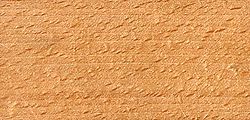This article needs additional citations for verification. (November 2014) |
Hardwood is wood from angiosperm trees. These are usually found in broad-leaved temperate and tropical forests.[1] In temperate and boreal latitudes they are mostly deciduous, but in tropics and subtropics mostly evergreen. Hardwood (which comes from angiosperm trees) contrasts with softwood (which is from gymnosperm trees).

Characteristics
Hardwoods are produced by angiosperm trees that reproduce by flowers, and have broad leaves. Many species are deciduous.[2] Those of temperate regions lose their leaves every autumn as temperatures fall and are dormant in the winter, but those of tropical regions may shed their leaves in response to seasonal or sporadic periods of drought. Hardwood from deciduous species, such as oak, normally shows annual growth rings, but these may be absent in some tropical hardwoods.[3]
Hardwoods have a more complex structure than softwoods and are often much slower growing as a result. The dominant feature separating "hardwoods" from softwoods is the presence of pores, or vessels.[4] The vessels may show considerable variation in size, shape of perforation plates (simple, scalariform, reticulate, foraminate), and structure of cell wall, such as spiral thickenings.
As the name suggests, the wood from these trees is generally harder than that of softwoods, but there are significant exceptions. In both groups there is an enormous variation in actual wood hardness, with the range in density in hardwoods completely including that of softwoods; some hardwoods (e.g., balsa) are softer than most softwoods, while yew is an example of a hard softwood.
Chemistry
The structural polymers of hardwoods are cellulose, hemicellulose, and lignin.[5] The constituents of hardwood lignin differs from those included in softwood. Sinapyl alcohol and coniferyl alcohol are the main monomers of hardwood lignin.[6]
Hardwoods contain less amount of non-structural constituents, named extractives, than softwoods.[7] These extractives are usually categorized into three broad groups: aliphatic compounds, terpenes and phenolic compounds. Aliphatic compounds found in hardwoods include fatty acids, fatty alcohols and their esters with glycerol, fatty alcohols (waxes) and sterols (steryl esters), hydrocarbons, such as alkanes, sterols, such as sitosterol, sitostanol and campesterol.[8] The terpene content of the hardwood significantly differs from the softwood, and mainly consists of triterpenoids, polyprenols and other higher terpenes. Triterpenoids commonly purified from hardwoods include cycloartenol, betulin and squalene. Hardwood polyterpenes are rubber, gutta percha, gutta-balatá and betulaprenols.[7][8] Although in small quantities, hardwoods also contain mono-, sesqui- and diterpenes, such as α- and β-pinenes, 3-carene, β-myrcene, limonene, hinokitiol, δ-cadinene, α- and δ-cadinols, borneol. Hardwood is rich in phenolic compounds, such as stilbenes, lignans, norlignans, tannins, flavonoids.[8]
Applications
Hardwoods are employed in a large range of applications, including fuel, tools, construction, boat building, furniture making, musical instruments, flooring, cooking, barrels, and manufacture of charcoal. Solid hardwood joinery tends to be expensive compared to softwood. In the past, tropical hardwoods were easily available, but the supply of some species, such as Burma teak and mahogany, is now becoming scarce due to over-exploitation. Cheaper "hardwood" doors, for instance, now consist of a thin veneer bonded to a core of softwood, plywood or medium-density fibreboard (MDF). Hardwoods may be used in a variety of objects, but are most frequently seen in furniture or musical instruments because of their density which adds to durability, appearance, and performance. Different species of hardwood lend themselves to different end uses or construction processes. This is due to the variety of characteristics apparent in different timbers, including density, grain, pore size, growth and fibre pattern, flexibility and ability to be steam bent. For example, the interlocked grain of elm wood (Ulmus spp.) makes it suitable for the making of chair seats where the driving in of legs and other components can cause splitting in other woods.[citation needed]
Cooking
There is a correlation between density and calories/volume. This makes the denser hardwoods like oak, cherry, and apple more suited for camp fires, cooking fires, and smoking meat, as they tend to burn hotter and longer than softwoods like pine or cedar whose low-density construction and highly-flammable pitch make them burn quickly and without producing quite as much heat.[citation needed]
See also
References
- ^ John N. Owens; H. Gyde Lund (2009). Forests And Forest Plants – Volume II. EOLSS Publications. p. 134. ISBN 978-1-905839-39-1. Extract of page 134
- ^ Nix, Steve (December 20, 2022) [Originally published April 22, 2021]. "Identification of the Most Common Hardwoods". Treehugger. Retrieved June 4, 2024.
- ^ MinuteEarth (October 9, 2020). "Why Hardwoods Are The Softest Woods". YouTube. Archived from the original on 2021-12-21.
- ^ CRC Handbook of Materials Science, Vol IV, pg 15
- ^ Ansell, Martin P. (2015). "Chapter 11: Preservation, Protection and Modification of Wood Composites". Woodhead Publishing Series in Composites Science and Engineering: Number 54. Wood Composites. Cambridge, UK: Woodhead Publishing. ISBN 978-1-78242-454-3.
- ^ Boerjan, Wout; Ralph, John; Baucher, Marie (June 2003). "Ligninbiosynthesis". Annual Review of Plant Biology. 54 (1): 519–546. doi:10.1146/annurev.arplant.54.031902.134938. PMID 14503002.
- ^ a b Ek, Monica; Gellerstedt, Göran; Henriksson, Gunnar (2009). "Chapter 7: Wood extractives". Pulp and Paper Chemistry and Technology. Volume 1, Wood Chemistry and Wood Biotechnology. Berlin: Walter de Gruyter. ISBN 978-3-11-021339-3.
- ^ a b c Sjöström, Eero (October 22, 2013). "Chapter 5: Extractives". Wood Chemistry: Fundamentals and Applications (Second ed.). San Diego: Elsevier Science. ISBN 978-0-08-092589-9.
Further reading
- Schweingruber, F.H. (1990) Anatomie europäischer Hölzer—Anatomy of European woods. Eidgenössische Forschungsanstalt für Wald, Schnee und Landscaft, Birmensdorf (Hrsg,). Haupt, Bern und Stuttgart.
- Timonen, Tuuli (2002). Introduction to Microscopic Wood Identification. Finnish Museum of Natural History, University of Helsinki.
- Wilson, K., and D.J.B. White (1986). The Anatomy of Wood: Its Diversity and variability. Stobart & Son Ltd, London.
External links
- Center for Wood Anatomy Research Archived 2022-01-21 at the Wayback Machine